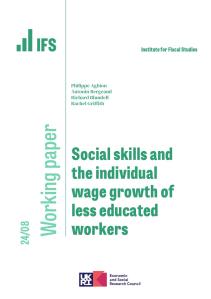Lowering the benefit cap led to small increases in employment, take-up of exempting benefits, and house moves – but vast majority of those affected did not respond in any of those ways.
Today the Department for Work and Pensions (DWP) has published new evidence on the impact of the benefit cap. First introduced a decade ago, this policy caps the total amount that some working-age families can receive in benefits. By affecting those with the highest benefit entitlements, it primarily affects families with children and/or high rents. Exemptions apply for those receiving certain benefits (e.g. disability benefits) and for many families who have had someone earning above a certain amount within the past 9 months. The new research examines the impacts of lowering the cap between November 2016 and January 2017.
Consistent with earlier evidence on the impacts of introducing the original cap, a new report based on quantitative analysis of DWP’s own data shows that the benefit cap has led to some individuals moving into paid work, moving home, or onto a benefit that exempted them from the cap. Most of those affected by the cap do not respond in any of those ways, however. It is therefore no surprise to see, in an accompanying report based on survey evidence, that other impacts include cutbacks to spending, more arrears on bills, and borrowing from friends or family.
The cap was initially set at £26,000 per year (or £18,200 for single adults with no dependent children) in 2013 by the coalition government. In 2014 the Department for Work and Pensions carried out a quantitative assessment of the impact of the cap, which IFS researchers peer-reviewed. Between November 2016 and January 2017 the cap was lowered to £20,000 outside of London (£13,400 for single adults without children) and to £23,000 in London (£15,410). The impact of this reform has been evaluated by the DWP, building on their earlier study, and again we have provided peer-review and advice on the methods employed. It is worth bearing in mind that the reform in question was completed more than six years ago – the publication of the report was delayed significantly, compared to the intention stated originally “to publish in spring 2019” – and that the most recent change to the cap has in fact been an inflation increase of 10.1% as of this month (the first nominal increase in its lifetime).
The level of cap, plus the exemptions from it, mean that the overall fiscal consequences are small. The latest statistics are from November 2022 and show that around 112,000 households were subject to the cap in that month, which is up from around 60,000 immediately after the cap was lowered (and 20,000 prior to the cap being reduced). In November most affected households contained children, and about half of affected households had a child aged 5 or under. And despite the fact that London now has a higher cap, about half of capped households are in London or the South East. On average, those capped have their benefits reduced by about £50 per week (implying that the policy has the direct impact of reducing benefit spending by less than £300 million a year). But the impacts on households are skewed: almost 1,000 households saw their monthly universal credit award reduced by £1,000 or more in November as a result of the benefit cap.
Identifying causal impacts of policies is rarely easy, but DWP have conducted careful econometric analysis which does allow conclusions to be drawn about the likely effects. In particular the study tracked outcomes 12 months after households became affected by the lower cap, and looked at whether the lowering of the cap had increased the chances of being in paid work, or receiving an exempting benefit, or of having moved house, at that 12-month point. It finds:
- Movements into paid work. The analysis estimates that out of 100 households affected by the lowering of the benefit cap we would have expected 18 to be in paid work 12 months later (as proxied by receipt of Working Tax Credit, which exempts families from the cap) even without any policy change. The impact of lowering the benefit cap was to increase this by 5. This effect, while significant across all groups, was found to be stronger for those whose benefit income was reduced most (i.e. those already subject to the original cap) and for those with pre-school children. It is possible that some of the effect comes from adults who were already in paid work but not claiming Working Tax Credit now taking up their entitlement or increasing hours of work to become eligible. This impact of lowering the benefit cap will come on top of the impact of the cap being in place, which the earlier DWP report also estimated would increase movements into paid work by about 5 percentage points.
- Movements onto exempting benefits. Out of 100 households affected by the lowering of the benefit cap we would have expected 7 to be receiving an exempting benefit anyway when followed up 12 months later. The impact of the benefit cap was to increase this by 3. Again this effect, while significant across all groups, was found to be stronger for those who lost more benefit income and for those with pre-school children. Being capped was found to lead to households more likely to start receiving carer’s allowance and/or child disability allowance, with increased receipt of personal independence payments also found. This means that some households will have seen their benefit income increased as a result of the benefit cap, and where it has boosted take-up of benefits among those eligible for them then a strong case could be made that this is a positive outcome of the policy.
- House moves. Out of 100 households affected by the benefit cap we would have expected 18 to move home (as defined by a change in census output area, which are geographical areas covering between 40 and 250 households) anyway within 12 months. The impact of the benefit cap was to increase this by 2. This effect was found to be stronger for those losing more benefit income and for single parents rather than couples with children. The effect was seen only among those in the private rented sector, which is what we might expect, as those in the social rented sector are likely to find it particularly hard to move to cheaper accommodation. The additional house moves were also short range: there was no evidence of individuals moving to a different local authority as a result of the benefit cap.
As is typical, then, changing benefit entitlements causes households to respond in a variety of ways. However, the numbers above imply that about 90% of individuals subject to the cap do not respond by moving into paid work, moving onto an exempting benefit or moving house. As we pointed out at the time, exactly the same could be said about the findings from DWP’s 2014 evaluation of the original benefit cap. Helpfully, DWP have also published a separate study based on surveys conducted by the National Centre for Social Research (NatCen) which sheds light on some of the other ways that households have adjusted to what is, in many cases, a substantial loss of income. This suggests that cutting back on spending, increased arrears on bills, and borrowing from friends or family, were not uncommon responses.
As mentioned, this all refers to the impacts of lowering the benefit cap more than six years ago. This month, we actually saw the first ever cash increase in the benefit cap: for those outside London it is now set at £22,020 (£14,753 for single adults without dependent children) while in London it is now set at £25,323 (£16,967). The fact that it has been increased in line with the 10.1% rise in most other working age benefits is welcome, as if we are to have a benefit cap it should – at least by default – be increased in line with the cash value of the benefits to which it applies. The findings in the DWP report published today suggest that allowing the real value of the cap to continue to decline, as was happening, was likely resulting in a small number of additional families moving in to paid work, claiming an exempting benefit or moving house as they were dragged within scope of the cap each year. However, more than any of that, it was resulting in additional cuts year-on-year to the real value of some families’ incomes. This year, for the first time since the benefit cap’s introduction, that has not happened. The value of benefits is a political choice – but then it should be chosen, rather than determined by unknown future rates of inflation. The cash increase to the cap this year achieves that, for one year at least.











